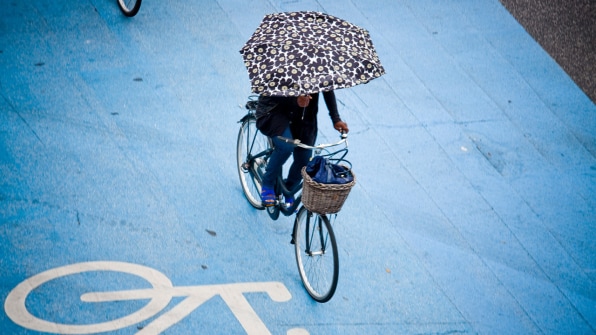-Fast Company
Designing a city for bicycles is not just a pleasant idea for the cyclists among us. Designing a city for bikes will also achieve the goals we want for our future urban centers, making them more equitable, healthy, efficient, and clean. Cities that prioritize bikes over cars effectively reduce carbon emissions, and support public health both by creating clearer air for people to breathe and more opportunities for safe, active transportation. Bikes also enable many more people to move through the streets at a time than do cars, and when cities are especially concerned with overpopulation and congestion on the roads, bikes emerge as the more efficient option.
The bicycle’s ability to address all these concerns makes now, according to Colville-Andersen, an ideal time for cities to re-embrace the bicycle as a primary mode of urban transit.
“It’s tricky,” he says. “We live in an age of tech and over-complication, where we like to look to things we haven’t invented yet as solutions.” But in doing so, “a lot of really good, already existing ideas get swept under the rug.” The bicycle is a prime example of that. While it may seem antithetical to the forward-looking ethos of our tech-dominated culture, Colville-Andersen is convinced that cycling is the mode of transit of the future. Getting there, though, will take some changes.
In Copenhagen, around 5,900 people per hour bike along the city’s cycle track–a designated lane for bicyclists. (Around 10 bikes can fit in the space of one car.) As cities grapple with congestion and gridlock, cycling emerges as a spatially efficient, high-density alternative to vehicular traffic, and one that can complement mass-transit service like buses, instead of competing with it.
Cycling also addresses obesity and declining mental health. “It’s incredibly important for our survival for people to be able to choose an active mobility form,” Colville-Andersen says, referring to the exercise benefits of cycling. But there are also more intangible positives: Because cyclists are more engaged with the street and their surroundings, researchers have found that cycling alleviates some of the loneliness often held up as a major driver of mental illness. (This also applies to walking, and the transition away from car culture that will welcome bikes will also encourage pedestrianization.)
And the last but most pressing consideration: safety. Drivers kill around 1.3 million people each year. Statistics for deaths caused by cyclists are harder to pin down, but a study found that in 2016 in Great Britain, three people died after being struck by a cyclist (the number of vehicular-driven fatalities that year in the U.K.: 1,792). Still, the idea that people on bikes are hazards persists: In Queens, New York, a woman spoke out against protected bike lanes running next to a school, saying that the lanes “put children at risk of being hit by cyclists instead of cars.” Those arguments often ignore the fact that vehicular crashes are by far the more dangerous. “There’s a misconception that cycling creates danger in cities,” Colville-Andersen says, “but there’s no statistical evidence to back this claim.” In fact, cities that have increased the bicycling mode-share report significantly lower road fatality rates than those dominated by cars.

No comments:
Post a Comment